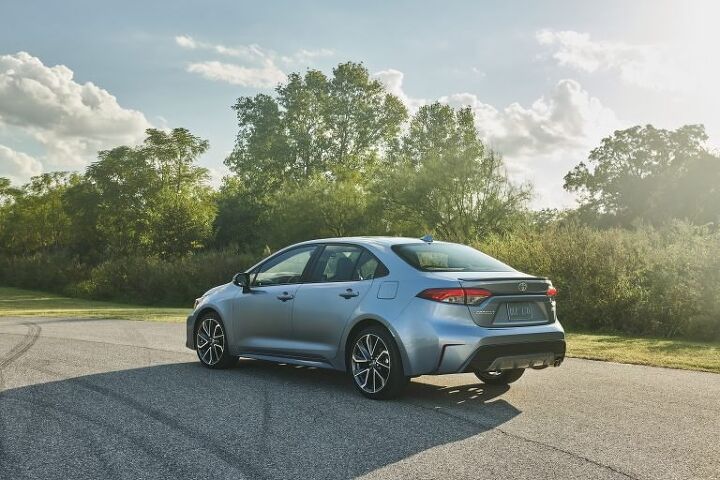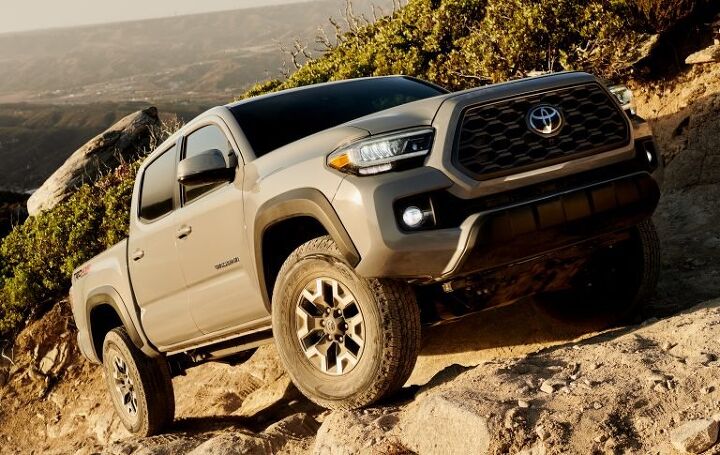What Slump? Toyota Ekes Out Its Best November to Date

While U.S. auto sales are expected to slump further this year, continuing a trend in the industry, certain products seem impervious to market pressures. Take the Toyota Tacoma, for example. Hardly the newest kid on the block, the Tacoma nonetheless manages to consistently retain buyers while capturing new ones.
Like its parent company, the Tacoma just posted its best-ever November sales month. And wouldn’t you know it — early results are in, and the new Corolla seems to be a hit.
It’s important not to place too much stock in the first few months of sales for a redesigned model, but the revamped compact sedan, now available as a hybrid, saw its year-over-year sales increase 17.3 percent last month. Toyota as a whole recorded a 9.2 percent YoY gain, its best showing for the 11th month of the year.
Breaking down that figure into brands, the company’s namesake division rose 8.4 percent last month. Lexus posted a better showing, with volume up 13.8 percent; every crossover in the brand’s lineup gained volume for the month, and the recently redesigned ES continues to gain momentum, with a YoY gain of 7.7 percent. It’s year-to-date volume is up 7.5 percent.
As for the Corolla, the model is now in the black for the year, up 1.0 percent. That’s no small feat for any compact passenger car, or any car at all, for that matter. The Camry saw its sales rise 4.3 percent for the month, pushing the model closer to breaking even for the year.
One thing Toyota has going for it, besides ridiculous brand loyalty and a reputation for reliability and good resale value, is the availability of hybrid power. Hybrid power for relatively little additional cost, we should add. Sales of hybrids across both brands were up over 65 percent in November, with the YTD tally coming in at 26.6 percent.
If you’ve got the cash to cover the development of such products, having a lot of choice on hand is a nice thing which which to lure picky buyers. Hence Toyota’s decision to offer as many hybrids and TRD variants as possible, not to mention all-wheel drive on traditionally front-drive products like the Prius, Camry, and Avalon. (The latter two AWD models won’t be available for several months, however.)
Combine all of that choice and you end up with the RAV4, which beat its previous November showing by over 26 percent.
In the truck realm, the Tacoma once again proved that it can do no wrong, posting a 5.3-percent YoY sales hike. Through the end of November, Tacoma sales are up 1.8 percent, despite the presence of a new rival in the form of the Ford Ranger.
Did all of this winning help Toyota break even, overall? Nope. The brand is still down 1.4 percent for the year, though Lexus sales are up by exactly three vehicles over this time last year. What’s important is that the brand’s higher-volume stalwarts are still doing well, and the cash sunk into recent redesigns seems to be paying off.
Thinking about the incentives angle? ALG data shows the brand’s incentive spend per vehicle rose 1 percent, year over year, in November, with the actual dollar amount being more than a grand less than the industry average.
[Images: Toyota]

More by Steph Willems
Latest Car Reviews
Read moreLatest Product Reviews
Read moreRecent Comments
- Corey Lewis It's not competitive against others in the class, as my review discussed. https://www.thetruthaboutcars.com/cars/chevrolet/rental-review-the-2023-chevrolet-malibu-last-domestic-midsize-standing-44502760
- Turbo Is Black Magic My wife had one of these back in 06, did a ton of work to it… supercharger, full exhaust, full suspension.. it was a blast to drive even though it was still hilariously slow. Great for drive in nights, open the hatch fold the seats flat and just relax.Also this thing is a great example of how far we have come in crash safety even since just 2005… go look at these old crash tests now and I cringe at what a modern electric tank would do to this thing.
- MaintenanceCosts Whenever the topic of the xB comes up…Me: "The style is fun. The combination of the box shape and the aggressive detailing is very JDM."Wife: "Those are ghetto."Me: "They're smaller than a Corolla outside and have the space of a RAV4 inside."Wife: "Those are ghetto."Me: "They're kind of fun to drive with a stick."Wife: "Those are ghetto."It's one of a few cars (including its fellow box, the Ford Flex) on which we will just never see eye to eye.
- Oberkanone The alternative is a more expensive SUV. Yes, it will be missed.
- Ajla I did like this one.




































Comments
Join the conversation
"True fact: 40.5% of customers coming from Toyota decide to buy a brand other than Toyota. Why is this (and what are they thinking)? Serious question." Is this comment intended to be sarcastic?
@johnny, in US trim levels, the SE with the Preferred Package seems to be the good spot. One minor annoyance is the wheels. The SE 16's are plain, while the XSE 18's have sidewalls that are too short for my taste (bad roads, ride quality). The only substantive mechanical difference between the 2 trims seems to be the wheels, but the 18" choice results in a 2-3 MPG penalty. Thats not insignificant. I prefer the heated seats, grille bling, and fog lights of the XSE, and I'm neutral on fabric vs. pleather seats, probably leaning towards fabric.